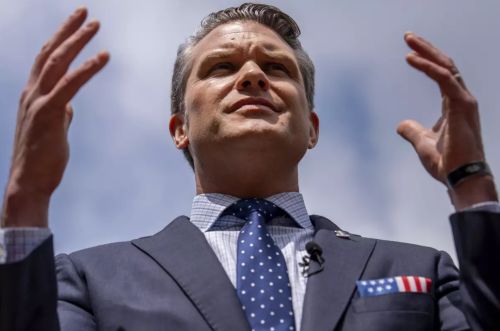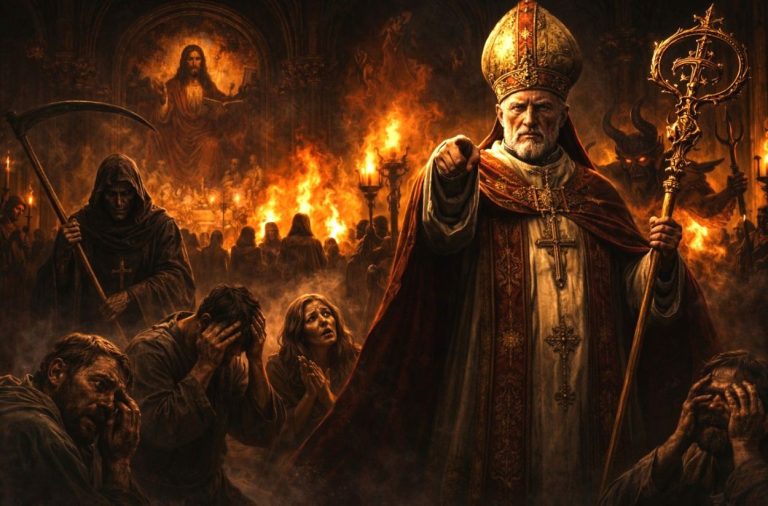

Pete Hegseth’s embrace of Christian nationalism inside the Pentagon is more than symbolic. It is a test of how resilient the American republic remains.

By Matthew A. McIntosh
Public Historian
Brewminate
A Military Turning Toward the Sacred?
In August 2025, newly installed Defense Secretary Pete Hegseth appeared before an audience of officers and chaplains at the Pentagon, invoking biblical imagery with a confidence that signaled more than ceremonial faith. His words carried echoes of the “Christian soldier” ideal, long associated with culture war politics but rarely broadcast from the highest office of military command. Alongside his speeches came practical steps: the reintroduction of formal Christian prayer services in military gatherings, endorsements of conservative denominations that promote patriarchal family structures, and reposted statements on social media questioning women’s suffrage.
Such gestures may seem symbolic, but within the Pentagon their weight is unmistakable. For decades, civilian leaders have worked to ensure that America’s armed forces remain officially secular, reflecting the pluralism of the nation. Hegseth’s interventions challenge that posture. The concern is not only theological. It is institutional, striking at the balance between faith and democratic governance in one of the most powerful bureaucracies in the world.
A History of Guardrails
The U.S. military has always been a site of tension between personal faith and professional neutrality. Chaplains have been part of its structure since the Revolutionary War, and soldiers have carried religious practice into every conflict. Yet the legal framework, strengthened through Supreme Court precedent and military regulation, has emphasized that the state must not privilege one faith over another.
Moments of drift are not unprecedented. After September 11, military academies drew criticism for fostering evangelical cultures that sometimes blurred into command authority. Lawsuits from groups like the Military Religious Freedom Foundation highlighted patterns of proselytizing and coercion. These controversies eventually spurred reforms, training modules, and clarifications about the limits of religious expression within hierarchical chains of command.
What makes the present moment distinct is scale. The difference between isolated cultural disputes and a Defense Secretary publicly aligning Pentagon policy with a particular faith tradition is vast. It reopens questions that many assumed had been settled, raising the specter of military culture being reshaped from the top down.
The Rise of Christian Nationalism
Christian nationalism, a political ideology that frames the United States as fundamentally Christian and destined to be governed by biblical principles, has moved from the margins of political debate into its mainstream. Polls conducted by the Public Religion Research Institute show that nearly 30 percent of Americans agree with core tenets of this view or sympathize with it. Within Republican Party circles, its influence is even stronger.
Pete Hegseth has long been identified with this current. As a Fox News personality and commentator, he praised leaders who embraced overt religious imagery and criticized secular norms as evidence of national decline. His appointment to the Pentagon under President Donald Trump’s administration was celebrated by Christian nationalist groups as a breakthrough. They now see the world’s largest military organization as a platform for affirming their narrative of faith and strength.
The symbolic return of Christian prayer services within the Pentagon is therefore not just ritual. It reflects an effort to weave religious identity into the fabric of military life, reinforcing a vision of the armed forces as not only American but also Christian in character.
Gender, Authority, and Patriarchal Currents
Hegseth’s public reposting of critiques of women’s suffrage has sparked particular alarm. While he has not articulated a formal position against women’s political rights, the amplification of such arguments signals affinity with movements that link Christian nationalism to patriarchal structures. Within the military, where women now make up roughly 17 percent of active-duty personnel, such gestures are more than rhetorical. They suggest an endorsement of voices that would marginalize female service members by grounding authority in male religious leadership.
For officers and enlisted personnel alike, confidence in institutional neutrality is not a minor issue. A military perceived as privileging one gender or faith risks fracturing the trust essential for cohesion. Internal surveys have shown that younger service members are more religiously diverse and less likely to identify as Christian compared with their older counterparts. If leadership rhetoric tilts toward exclusionary ideologies, generational rifts may deepen.
Democratic Norms and Civilian Oversight
The U.S. military is designed to serve civilian authority, not to dictate it. That principle rests on two assumptions: the civilian leadership must itself remain accountable to democratic norms, and the military must embody professional neutrality. When a civilian leader introduces overt religious politics into military life, both assumptions come under strain.
Civil liberties advocates warn that aligning the Pentagon with Christian nationalism undermines the Constitution’s establishment clause and threatens to normalize favoritism within an institution meant to stand above sectarian divides. Retired officers, speaking anonymously to reporters, describe unease among the ranks. “It is one thing for a soldier to pray in private,” said one. “It is another for the Secretary of Defense to frame military service as an explicitly Christian calling.”
If the United States military comes to be seen abroad as an instrument of religious ideology, the consequences could extend beyond internal morale. International coalitions depend on trust that American forces represent the secular democratic state, not a religious crusade. For allies in Europe, many of whom are already wary of far-right nationalism, the optics are deeply troubling.
The Limits of Power and the Fragility of Norms
For now, the Pentagon remains governed by law. Regulations on equal opportunity, nondiscrimination, and religious freedom are still intact. Yet the line between formal law and cultural practice is often thinner than it appears. If senior leaders signal tolerance for one ideology, the message filters down quickly.
History offers cautionary examples. From the Roman legions, where emperors imposed cult worship, to twentieth century fascist states that blended military power with political myth, the militarization of faith has consistently eroded civilian institutions. The United States is not Rome, and the Pentagon is not a medieval church, but the underlying dynamic is recognizable. Once norms are weakened, restoring them requires more than legal correction. It requires cultural renewal.
Conclusion: A Test for the Republic
Pete Hegseth’s embrace of Christian nationalism inside the Pentagon is more than symbolic. It is a test of how resilient American democracy remains when faith politics seep into its most powerful institutions.
The N.S. Savannah once symbolized Eisenhower’s “Atoms for Peace,” marrying technological ambition with public hope. Today the Pentagon stands at a different kind of crossroads. If religious nationalism becomes enshrined in the command culture of the U.S. military, the implications will not be limited to doctrine. They will touch on the cohesion of the armed forces, the confidence of the American people, and the stability of democratic rule itself.
The republic was built on the principle that the military belongs to the people, not to any single creed. Whether that principle endures in the years ahead may depend on how seriously Americans confront the specter of Christian nationalism in uniform.
Originally published by Brewminate, 08.29.2025, under the terms of a Creative Commons Attribution-NonCommercial-NoDerivatives 4.0 International license.


